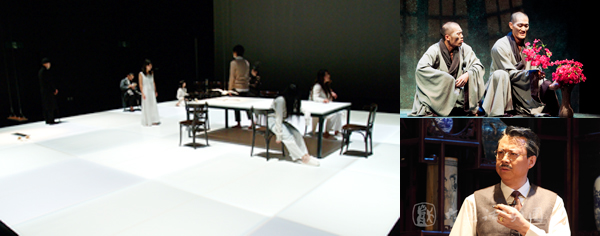NE Asian theater takes center stage

Clockwise from left: Scenes from “The Seagull,” “A Dream” and “Thunderstorm.” The three works, along with “Cape Moon,” are featured during the 2012 BeSeTo Theatre Festival this week in Seoul. Provided by the theater groups
In the early 1990s, Korean playwright Kim Eui-kyung first came up with the idea of an annual festival with Japan and China to deepen understanding of the theater scenes among the three countries.
At the time, the countries’ understanding of each others’ modern or contemporary cultures was quite limited, despite millenniums of shared history. Korea’s diplomatic relations with China started in 1992. Japan’s mass popular culture, long eschewed by Koreans with bitter memories of colonial rule, was little known as recently as the late 1990s.
When Kim went to Tokyo and Beijing in 1994 to pitch his idea, Japanese director Tadashi Suzuki and Chinese director Xu Xiaozhong listened. And the BeSeTo Theatre Festival was born.
Since then, the festival has weathered chronic shortages of cash and organizational resources, as well as political tensions, to become one of the longest-running cultural exchange programs in the region. This week marks its 19th consecutive year.
The festival has been held in major cities of the participating countries. With Seoul the site of the event for the seventh time, organizers have expanded their vision from mutual understanding to raising the profile of East Asian theater in the rest of the world.
“It is great to see that we could manage to bring this event this far,” said Kim, 75, who leads a theater research institute in Seoul.
Most festival plays are handpicked by a BeSeTo committee in each country. The latest Seoul event showcases four plays: “A Dream,” the flagship play of the National Theater Company of Korea; “Cape of Moon” by the Japanese group Seinendan; “The Seagull” by another Japanese group Dainanagekijo; and China’s “Thunderstorm” by Dalian Drama House.
“Cape of Moon” closed on Wednesday after its second performance, but the other three works will run through the weekend at the National Theater Company of Korea, Myeongdong Theater and the Namsan Arts Center.
“A Dream,” which opened Tuesday, is the first work in the National Theater Company’s “Samguk Yusa Project” to produce a series of plays based on a 13th-century account of ancient Korea’s legends and folktales.
“Cape of Moon” received several honors in Japan, including the Yomiuri Drama Award for Best Production of 1998. “The Seagull,” a modern adaptation of the Anton Chekhov classic, has been well received by foreign critics. “Thunderstorm” is representative of the works of Cao Yu, often dubbed China’s Shakespeare.
There are no joint productions this year, but in several previous events, Korean, Japanese and Chinese professionals collaborated, pulling together actors, writers and directors. “Tale of Chunhyang” was staged in Seoul in 2000 and drew on traditional opera genres of the three countries, Korean changgeuk, Chinese yueju and Japanese kabuki.
“Many audiences responded positively to it as it was a rare chance to compare each of the traditional performing arts of the three countries all at once,” said Lee Eung-su, a drama professor at Sejong University.
The most recent joint work, “Tokyo Note,” based on Oriza Hirata’s play of the same name, was performed at the 2010 festival in Tokyo and received a critical reception that was more favorable than that for his original work, Hirata said.
The festival also has served as a catalyst for further exchanges. In 2002, Korea and Japan teamed up for a production based on another Hirata play that won several awards in both countries. Another joint project between Japan and China was staged in 2006.
Wang Xiaoying, a leading member of the Chinese BeSeTo committee, said the festival is becoming a channel through which a growing number of Chinese theater groups are communicating with the outside world. “It is a good source of inspiration and a platform of exchange,” he said.
In the past, the festival has invited theater groups from India, Russia, Mongolia and Uzbekistan to perform.
Those were one-time invitations, and at a roundtable discussion at the Myeongdong Theater on Wednesday, representatives of the three regular participating countries talked about how to expand the festival’s influence beyond the region.
Among the topics were using themes for each year’s festival, holding academic symposiums and staging joint works that target wider audiences.
Hirata said he wants to take a joint work to Europe or the United States, the two regions where there is growing interest in Northeast Asian theater. “I want to start working on the plan next year, when Japan will host the 20th festival,” he said.
Many of the ideas discussed, however, were similar to ones brought up during previous festivals that never materialized due to a lack of financial and administrative resources.
Support for the festival from the three governments has been limited, and some Korean organizers are concerned it could dwindle further if diplomatic relations worsen.
Li Huayi, one of the Chinese representatives at the BeSeTo festival, noted that the three countries have a long “face-reddening” history with one another, but said the theater festival should be free of politics.
“Despite conflicts facing us, I think we need to cherish the opportunity to share our common identity as Asians,” she said.
By Moon Gwang-lip [joe@joongang.co.kr]
* “The Seagull” will be performed today and tomorrow at the Namsan Arts Center, while “Thunderstorm” shows will be tomorrow and Sunday at the Myeongdong Theater. “A Dream” will run today through Sunday at the Baek Seonghui & Jang Minho Theater at the National Theater Company of Korea. Performances will be at 8 p.m. today and 3 p.m. Saturday and Sunday.
* Tickets are priced from 15,000 won ($13.20) to 50,000 won. Korean subtitles are shown.










with the Korea JoongAng Daily
To write comments, please log in to one of the accounts.
Standards Board Policy (0/250자)